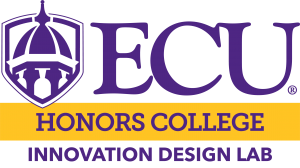eNC Innovates! Fellowship

The Honors College Innovation Design Lab (IDL), in partnership with the US Department of US Economic Development Administration, is offering a new fellowship opportunity. The eNC Innovates! Fellowship provides a unique opportunity for undergraduates to engage in creative projects and research with the IDL. The IDL provides a neutral meeting ground for diverse, multi-disciplinary innovation teams where design is the translating language and connects the arts and the sciences. The IDL uses established Design Thinking processes to enhance creativity and guide its application into innovations. The fellowship is an eight-week commitment for the second block this fall. The time commitment is 10 hours per week, and the pay is $1,200.00 for the successful completion of the contract. Fellows have the option to work remotely.
Students selected for the fellowship will work with other students, faculty, and professional mentors based upon mutual interest in various project challenges. Student fellows may become proficient in
- 3D design and printing,
- the visual, translating language of design,
- leadership in the problem-solving innovation process, and
- communication of the social and investment value of their ideas and solutions.
Student fellows will present a document of their research findings at the end of the program. This will include a fundamental market analysis and a business model canvas. Additionally, student fellows will develop a proposal, create a presentation, and participate in local, regional, and state-wide innovation initiatives.
The objective of the fellowship is to expand the process of creating new products/services to create an environment that
- defines the science, technology and innovation needs of advanced manufacturing organizations to rapidly advance technical and mechanical maturity
- encourages, supports and fosters entrepreneurship and new business/venture creation
How To Apply
To apply to become a student fellow, send a resume and cover letter of 300 words or less addressing why you are applying to be an IDL fellow, and the challenge you choose to study answering these three questions:
- What existing assumptions might you have around the challenge?
- Why is there a chance for a new opportunity in the current landscape?
- What makes this challenge appealing to you, and what do you hope to learn and explore?
Send the application materials to Wayne Godwin godwinw@ecu.edu.
For more information about the program, please contact Wayne Godwin godwinw@ecu.edu
Potential Challenges Fellows Can Address
Fellows may create a response to a challenge they identify, or one of the six challenges identified below.
How might we inspire households to adopt healthier eating habits?
As a child, would you rather have eaten carrots or dessert? For most children, the answer is dessert. It just tastes better at that age. In 2013, an estimated 43 million children (under the age of five) suffered from early obesity globally, a 60% increase since 1990. Some might blame this increase on a shift in exercise habits with the advent of video games, tablets, and cell phones. Others might point to the family structure and a decline in family mealtime routines. Regardless of the cause, children have less focus and energy without proper nutritional intake. So, what might you do to solve this challenge? How might you inspire households to adopt healthier eating habits?
How might we provide new products and services for the modern 70-year-old?
Time passes, and we age. That’s about as certain as death and taxes. As we age, our daily routines can become trickier. Fortunately, there are many products that help with the aging process. You might have noticed the buttons on your grandfather’s telephone that appear larger than life. Or maybe lifts on public transportation that allow the elderly to get to their seat easier. Or even a service for improving quality of life, like global tourism for senior citizens. But what else has yet to be invented? How might you provide new products and services for today’s 70 year old?
How might we inspire industry and governments to increase the manufacturing of personal protective equipment to meet demand?
The World Health Organization has warned that severe and mounting disruption to the global supply of personal protective equipment (PPE) – caused by rising demand, panic buying, hoarding, and misuse – is putting lives at risk from the new coronavirus and other infectious diseases. Healthcare workers rely on personal protective equipment to protect themselves and their patients from being infected and infecting others. But shortages are leaving doctors, nurses, and other frontline workers dangerously ill-equipped to care for COVID-19 patients due to limited access to supplies such as gloves, medical masks, respirators, goggles, face shields, gowns, and aprons. “Without secure supply chains, the risk to healthcare workers around the world is real. Industry and governments must act quickly to boost supply, ease export restrictions, and put measures in place to stop speculation and hoarding. Since the start of the COVID-19 outbreak, prices have surged. Surgical masks have seen a sixfold increase, N95 respirators have trebled, and gowns have doubled. Supplies can take months to deliver, and market manipulation is widespread, with stocks frequently sold to the highest bidder. How might we encourage industry and governments to increase manufacturing by 40 percent, as the WHO calls to meet rising global demand? What else has yet to be invented? What new policies and procedures are needed?
How might we encourage children to read more?
Reading has been proven to have extremely positive effects on childhood development. Children who are avid readers often have better communication skills, more empathy, higher self-esteem, and advanced brain development. Yet studies have shown that reading for pleasure has declined sharply in recent years for children. Interestingly enough, the digital revolution has dramatically increased platforms to read on. But therein might lie the problem. Children are choosing to chat with friends online, watch movies and television, and game instead of reading for pleasure. But what if we could make reading fun again? How might you get kids to read more?
How might we encourage social distancing and everyday preventive actions to slow the spread of COVID-19 among 18-21-year-old college students?
Social distancing, also called “physical distancing,” means keeping a safe space between yourself and other people who are not from your household. To practice social or physical distancing, stay at least 6 feet (about 2 arms’ length) from other people who are not from your household in both indoor and outdoor spaces. Social distancing should be practiced in combination with other everyday preventive actions to reduce the spread of COVID-19, including wearing masks, avoiding touching your face with unwashed hands, and frequently washing your hands with soap and water for at least 20 seconds. COVID-19 spreads mainly among people who are in close contact (within about 6 feet) for a prolonged period. Spread happens when an infected person coughs, sneezes, or talks, and droplets from their mouth or nose are launched into the air and land in the mouths or noses of people nearby. The droplets can also be inhaled into the lungs. Recent studies indicate that people who are infected but do not have symptoms likely also play a role in the spread of COVID-19. Since people can spread the virus before they know they are sick, it is important to stay at least 6 feet away from others when possible, even if you—or they—do not have any symptoms. Social distancing is especially important for people who are at higher risk for severe illness from COVID-19. How might we encourage social distancing and preventive actions? What new policies or procedures are needed?
How might we encourage more purposeful collaboration in the workplace?
When tackling complex challenges in the workplace, it’s important to bring together diverse perspectives and skill sets. Once in place, teams need to find ways to collaborate. Collaboration in the workplace isn’t getting any easier: individuals can be spread out across the globe, share different values, and feel pressure to be independently efficient rather than collaborative. What might you do to promote cross-pollination and different ways of working together? How might you encourage more purposeful collaboration in the workplace?
